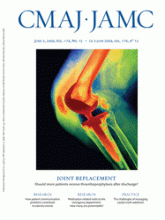- © 2008 Canadian Medical Association
The Anatomist: A True Story of Gray's Anatomy Bill Hayes; Ballantine Books; 2007; 272 pp $24.95 ISBN 978-0-345-45689
Pity Bill Hayes, the author of this new biography of Henry Gray, the British surgeon who gave the world Gray's Anatomy. A fitness buff, magazine freelancer and writer of 2 popular medical books, Hayes noticed there had never been a biography of the writer of the world's most famous anatomy textbook. He must have thought he heard the knock of opportunity tapping out “bestseller” on his laptop. But after a few library inquiries and search engine marathons it became apparent why the book had never been written: the good doctor had left a very cold trail. There was about as much personal detail about him in the archives as there was about the anonymous cadavers laid out on the pages of his textbook.
Photo by: Ballantine Books
While a few photographs of Gray survive, nearly all of his papers were lost in a fire that destroyed his publisher's archives the year he died and a mere handful of published scientific papers grace the shelves of medical libraries. Worse, he lived a tragically short life. He died in 1861, at the age of 34, of smallpox after treating his 10-year-old nephew for the disease, meaning a potentially interesting life swept along on a wave of early fame wasn't available to be written about.
What to do? Faced with same dilemma that bedevils biographers of Shakespeare, Hayes resorts to similar strategies to plug the gaps: he mixes personal experience with imaginative fantasies of what his subject's life might have been like in the social and scientific context of his time, mid-19th century England.
Starting with an examination of a photograph showing Gray surrounded by his students in the pathology lab, Hayes moves quickly to its contemporary equivalent. In San Francisco he signs up for a course in anatomy at the University of California, joining medical students in performing dissections and prosections. Much of the book is a first-person account of Hayes' experiences in the dissection lab and his reactions mirror that of Western civilization's conflicted relationship with post-mortem examination since Leonardo da Vinci first started hauling bodies out of the Arno. Fear is his initial reaction, then revulsion, curiosity and finally amazement and delight. In his final days at the lab he is almost gleeful as he peels back the skin and rattles off the names of the muscles attaching to the pes anserinus.
Hayes then goes to England, where he takes us along on research expeditions to Gray's home, St. George's Hospital in London (now a luxury hotel) and a small museum dedicated to his work.
If this were the extent of the story, this small volume might exude the faint odour of formaldehyde. Fortunately, Hayes finds another way to enliven and expand it. Gray's Anatomy is not the product of one mind, but two. Henry Gray wrote the text. Another Henry, artist/surgeon Henry Vandyke Carter, did the woodcut illustrations. And when Dr. Carter wasn't engraving woodblocks or wielding a scalpel in the pathology lab, he kept a diary. Little of it was about the writing and illustration of the book, but it does provide a glimpse into the life of a young doctor at the school where Gray taught and insight into Victorian medical education. It also shines a light into the soul of an introspective, deeply religious young man, struggling to find a direction for his life and career.
In many ways it's the most interesting part. As Hayes points out: “The sprawling paper trail left behind by H.V. Carter would lead me … into the troubled heart of a gifted man of science.” It's easy to forget in a secular age that 150 years ago the best science was being carried out by researchers who held strongly to the traditions of mainstream Christianity. Confronted, as Carter was, with the wondrous mechanics of the human body, he struggled to find a philosophy that reconciled scientific practicality with religious belief.
His relationship with Gray was far less burdensome than the one with God. As a student 4 years behind the gifted, fast-tracked Gray, he expressed an admiration that verged on awe. By the time Gray was 20, he was already the equivalent of an MD, by 25, a Fellow of the Royal Society and head of the anatomy museum. In a burst of intense activity that lasted a year and a half, these 2 young men produced the magnificent volume that turned the interior of the human body into a work of art and the learning of its parts into a pleasurable ordeal. It became the standard reference manual for generations of medical students. The irony is that Henry Gray, whose name is forever identified with it, is a near total mystery. The artist, Henry Carter, whose name is all but forgotten, left a fleeting but penetrating sketch for us to remember him by.









